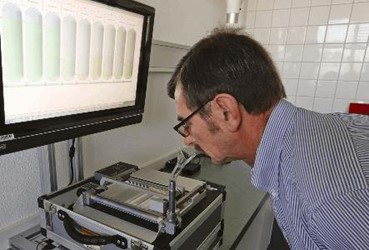Breathalyzer Diagnoses 17 Different Diseases Using A Single Breath

A team of Israeli scientists has further developed its breathalyzer technology, and a recent clinical study demonstrated an 86 percent success rate identifying 17 different diseases. The researchers’ nanoarray uses data collected from over 1,400 subjects to establish “breathprints” for diseases like cancer and multiple sclerosis, and then relies upon artificial intelligence (AI) technology to make a diagnosis.
The project, led by Hosam Haick from the Technion-Israel Institute of Technology, was first introduced in 2015 at the American Society of Clinical Oncology Conference. The technology — then called the NaNose breathalyzer system — demonstrated the ability to detect lung cancer with 90 percent accuracy, even when traditional imaging diagnostic techniques were non-conclusive and potentially cancerous nodules were too small to effectively biopsy.
“Current cancer diagnosis techniques are ineffective and impractical,” Haick told The Times of Israel when discussing the technology in 2014. A breathalyzer approach could “facilitate faster therapeutic intervention, replacing expensive and time-consuming clinical follow-up” that would result in the same intervention, said Haick.
When diseases grow in a body, they ramp up production of detectable chemicals, known as volatile organic compounds (VOCs). According to authors of a recent study published in ACS Nano, ancient medicine used “smell tests” to subjectively identify signs of diseases in a patient’s breath. Haick’s team has taken that premise and applied it to more objective and quantitative technology that is small enough to be used point-of-care.
To establish a “breathprint” of different diseases, researchers collected 2,800 breath samples from over 1,400 subjects, diagnosed with 17 different diseases using traditional methods. Each breath was analyzed for compounds and quantity ratios to establish connections between VOCs and disease, using a nanoarray made from gold nanoparticles and single-wall carbon nanotubes. This data was then plugged into AI technology and used in a device to diagnose diseases like multiple sclerosis, Chron’s disease, ulcerative colitis, a variety of cancers and chronic kidney failure. The device was accurate “nearly nine out of 10 times,” said researchers.
“Overall these findings could contribute to one of the most important criteria for successful health innovation in the modern era,” wrote the study authors, noting that the device was easy-to-use, affordable, and portable enough to be used as a point-of-care diagnostic, as well as holding the potential to identify more diseases beyond the 17 already demonstrated.
The Israeli project began in 2013 as a joint venture between Technion and Massachusetts-based Alpha Szenszor, a leading provider of nanotube-based sensors. Last year, Haick established a consortium with Siemens and research institutes in German, Austria, Finland, Ireland, and Latvia to develop similarly portable technology, and the European Commission awarded their efforts with a $6.8 million dollar grant.
The market for breathalyzer-related diagnostics and VOC-based research is heating up, according to CNN. A new medical journal — the Journal of Breath Research — will begin publishing in March of 2017.
Owlstone Medical recently received a CE mark for a breathalyzer to identify pediatric asthma. Researchers at Owlstone also announced progress in a breathalyzer used to detect lung cancer.
Additionally, research presented by New England University at the American Association of Pharmaceutical Scientists suggests that breathalyzer technology may be used one day in place of traditional finger-stick glucose testing.
